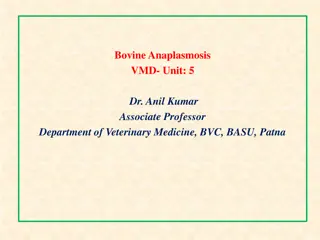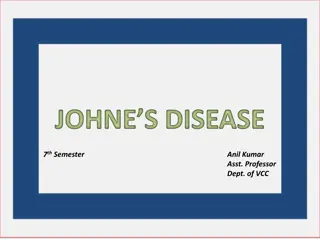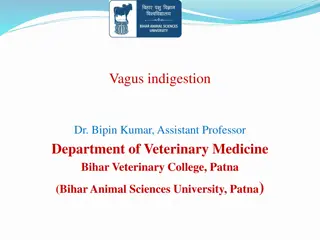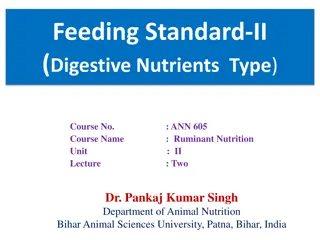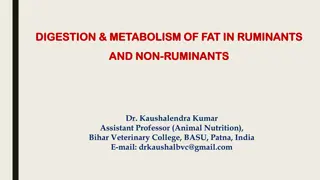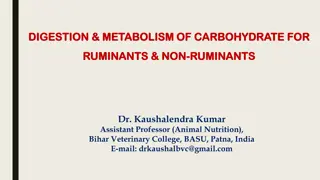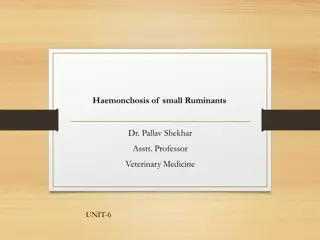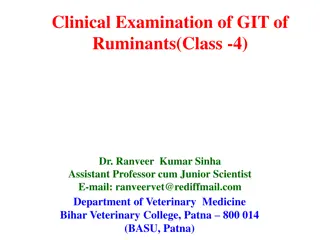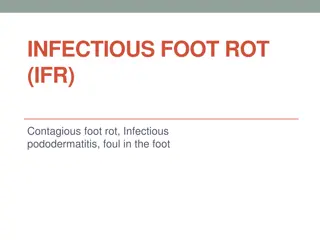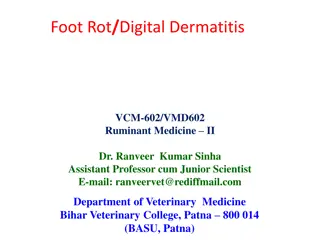Understanding Amphistomosis in Ruminants: Causes, Symptoms, and Diagnosis
Amphistomosis is a disease in ruminants caused by several types of rumen flukes. It leads to productivity losses, weight loss, fertility reduction, and other symptoms. Infection occurs through ingestion of contaminated vegetables and raw meat. The parasite affects the rumen and reticulum of sheep, goats, cattle, and water buffaloes. Diagnosis is challenging but relies on clinical signs, response to drenching, and postmortem analyses. Symptoms include anorexia, diarrhea, dehydration, anemia, and weight loss. Severe cases can lead to liver cirrhosis and nodular hepatitis.
Download Presentation

Please find below an Image/Link to download the presentation.
The content on the website is provided AS IS for your information and personal use only. It may not be sold, licensed, or shared on other websites without obtaining consent from the author. Download presentation by click this link. If you encounter any issues during the download, it is possible that the publisher has removed the file from their server.
E N D
Presentation Transcript
AMPHISTOMOSIS Amphistomosis ruminants superfamily Paramphistomoidea ,Fischoeder, 1901 (Lotfy et al. 2010). Etiology: It is belonging to several Paramphistomum, Calicophoron, Explanatum, Gigantocotyle and Carmyerius (Hajipour et al., 2020). The are rumen flukes, of which Paramphistomum cervii is more pathogenic. Infection occurs through: ingestion of contaminated vegetables and raw meat Through infective metacercaria are deposited from snails, which are the intermediate hosts(Indoplanorhis exustus, Gyraulus convexiusculus and Lymnea spp.) is a disease digenetic of domestic trematodes and wild the caused by of genera including: Cotylophoron,
It causes productivity losses including: Decrease in milk and meat production, Low nutrient conversion, Weight loss and Reduction in fertility. Adult amphistomes are the primary parasite of the rumen and reticulum of sheep, goats, cattle and water buffaloes The adult parasites are pear-shaped, pink or red and attach to the lining of the rumen. Immature forms are found in the duodenum A massive number of immature parasites migrating through the intestinal tract gastroenteritis with high morbidity and mortality rates, particularly in young animals (Gonz lez Warleta et al., 2013) and of immunologically incompetent hosts. Adult flukes are known to be quite harmless, as they do not attack on the host tissue. cause acute parasitic
Miracidia mollusk with cercariae emerging and typically encysting on vegetation, hard surfaces or water becoming metacercariae that grazing ruminants (final host) (Gonz lez-Warleta al., 2013; Waal, 2010) infect the ingest et Life cycle of Amphistomes
Pathogenesis and symptoms: The immature flukes which are most damaging as they get attached to the intestinal wall, and actively sloughing off of the tissue. It is indicated by haemorrhage in faeces Sign of severe enteritis The animal become anorexic and lethargic and often accompanied by pronounced diarrhoea, dehydration, oedema, polydipsia, anaemia, listlessness and weight loss. chronic form have severe emaciation, anaemia, rough coat, mucosal oedema, thickened duodenum and oedema in the sub maxillary space. In buffalos, severe haemorrhage was found to be associated with liver cirrhosis and nodular hepatitis (Ahmedullah et al., 2007)
Diagnosis: Under most situations, hard to recognize because the symptoms are mild or even absent. Diagnosis basically relies on a combination of postmortem analyses, clinical signs and response to drenching. In sheep and cattle, in heavy infection, the easily observed symptoms are anorexia or inefficiently digest food, and become unthrifty. Copious fetid diarrhea is an obvious indication, as the soiling of hind legs and tails with fluid feces are readily noticeable(Kumar, 1998 and Liu,2012) From the fluid excrement Immature flukes can be identified Rarely , eggs can be identified from stools of suspected animals (Olsen,1974). Multiple infections with other trematodes, such as Fasciola hepatica and schistosome can occur.
Treatment and Control: Resorantel, niclosamide, bithional and levamisole. Oxyclozanide (5 mg/kg body weight or 18.7 mg/kg body weight in two divided dose within 72 hours)is advocated as the drug of choice. Recents studies have shown that closantel is also effective in cattle at 10 mg/kg. Niclosamide is also extensively used in mass drenching of sheep. An in vitro demonstration shows that plumbagin exhibits high efficacy on adult fluke (Saowakon et al., 2013) Control of the snail population by using molluscicides (copper sulphate) oxyclozanide, clorsulon, ivermectin,
Lotfy, W.M., Brant, S.V., Ashmawy, K.I., Devkota, R., Mkoji, G.M. & Loker, E.S., 2010, Amolecular approach for identification of paramphistomes from Africa and Asia , Veterinary Parasitology https://doi.org/10.1017/S0031182000085383 Gonz lez-Warleta, M., Lladosa, S., Castro-Hermida, J. A., Mart nez-Ibeas, A. M., Conesa, D., Mu oz, F., Mezo, M. (2013). Bovine paramphistomosis in Galicia (Spain): Prevalence, intensity, aetiology and geospatial distribution of the infection. Veterinary Parasitology, 191, 252 263. https://doi.org/10.1016/j.vetpar.2012.09.006 Waal, T. D. (2010). Paramphistomum-a brief review. Irish Veterinary Journal, 63, 313 315. Hajipour, N., Mirshekar, F., Hajibemani, A., Ghorani M.(2020). Prevalence and risk factors associated with amphistome parasites in cattle in Iran. Vet Med Sci. 2020;00:1 7. 174, 234 240.
References: Ahmedullah F, Akbor M, Haider MG, Hossain MM, Khan M, Hossain MI, Shanta IS (2007). "Pathological investigation of liver of the slaughtered buffaloes in Barisal district". Bangladesh Journal of Veterinary Medicine. 5 (1 2): 81 85. doi:10.3329/bjvm.v5i1.132 Kumar V (1998). Trematode Infections and Diseases of Man and Animals (1 ed.). Springer, Netherlands. pp. 275 321. ISBN 978-0792355090. Liu D (2012). Molecular Detection of Human Parasitic Pathogens. Crc Press, Boca Raton, FL. pp. 365 368. ISBN 978- 1-4398-1242-6 Olsen OW (1974). Animal Parasites: Their Life Cycles and Ecology (3 ed.). Dover Publications, Inc., New York/University Park Press, Baltimore, US. pp. 273 274. ISBN 978- 0486651262 Saowakon N, Lorsuwannarat Wanichanon C, Sobhon P (2013). "Paramphistomum cervi: the in vitro effect of plumbagin on motility, survival and tegument structure". Experimental Parasitology. 133 (2): 179 186 N, Changklungmoa N,


